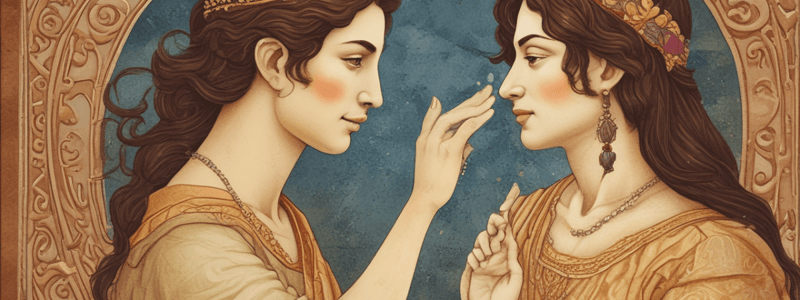Podcast
Questions and Answers
What is an artwork commissioned for?
What is an artwork commissioned for?
- To create a piece of art for a gallery
- To create a general piece of art
- To create a specific piece of art (correct)
- To create a piece of art for a museum
Which of the following is NOT a famous work of art by the artist mentioned?
Which of the following is NOT a famous work of art by the artist mentioned?
- The Starry Night (correct)
- The Last Supper
- The Vitruvian Man
- The Adoration of the Magi
What was a significant impact of Martin Luther's 95 Theses?
What was a significant impact of Martin Luther's 95 Theses?
- The fall of the Holy Roman Empire
- The end of the Renaissance
- The rise of Catholicism
- The start of the Protestant Reformation (correct)
What did Martin Luther translate into German during his exile?
What did Martin Luther translate into German during his exile?
What was a key factor in the Scientific Revolution?
What was a key factor in the Scientific Revolution?
Who discovered that the Earth revolves around the Sun?
Who discovered that the Earth revolves around the Sun?
What was a significant outcome of the Scientific Revolution?
What was a significant outcome of the Scientific Revolution?
What did mathematicians achieve during the Scientific Revolution?
What did mathematicians achieve during the Scientific Revolution?
What was the primary reason for the decline of Latin throughout Europe?
What was the primary reason for the decline of Latin throughout Europe?
Which language family is heavily influenced by Latin?
Which language family is heavily influenced by Latin?
What was Michelangelo's primary occupation?
What was Michelangelo's primary occupation?
Who introduced Michelangelo to influential scientists, philosophers, and poets?
Who introduced Michelangelo to influential scientists, philosophers, and poets?
What was the innovative feature of Michelangelo's scaffolding system in the Sistine Chapel?
What was the innovative feature of Michelangelo's scaffolding system in the Sistine Chapel?
What was the primary reason for Michelangelo's quick work on the Sistine Chapel fresco?
What was the primary reason for Michelangelo's quick work on the Sistine Chapel fresco?
What was the cultural and intellectual movement that Leonardo da Vinci lived during?
What was the cultural and intellectual movement that Leonardo da Vinci lived during?
Study Notes
The Spread of Latin and the Rise of Vernacular Languages
- Latin was spread throughout Europe by the Roman Empire
- After the fall of Rome, interest in educating the masses declined, leading to the rise of vernacular languages
- The Dark Ages (476-1066) saw the development of Romance languages, such as French, Spanish, Portuguese, Italian, and Romanian, which are heavily influenced by Latin
Michelangelo
- Born in Caprese, Italy in 1475
- Considered himself a sculptor above all other art forms
- Part of the "master trio" of Renaissance art, along with Leonardo da Vinci and Raphael
- Worked in the Medici gardens, influencing his art
- Introduced to scientists, philosophers, and poets through Lorenzo de Medici, which influenced his work
- Famous works include:
- Pieta
- Moses
- David
- The Last Judgment
- Notable achievements:
- Fresco painting on the Sistine Chapel
- Design of a unique, curved scaffolding system
Leonardo da Vinci
- 15th-century artist, inventor, anatomist, philosopher, and more
- Lived during the Renaissance in Italy
- Studied art at a young age and was commissioned to create works in his twenties
- Famous for his perspective of clarity in artwork, where distant objects are less distinct
- Notable works:
- The "Adoration of the Magi"
- The "Vitruvian Man"
- The "Last Supper"
- The "Mona Lisa"
- Inventive designs:
- Armored car
- Rudimentary robot
- Flying machine (forerunner to the helicopter)
The 95 Theses
- Published in 1517 by Martin Luther in Wittenberg, Germany
- Detailed Luther's opinions on Christian Scripture and practices of the Roman Catholic Church
- Criticized the Church's sale of indulgences to pay for sins
- Argued that humans can go to heaven through faith in Jesus, according to the Bible
- Led to the Protestant Reformation and the formation of Protestantism and Lutheranism
- Notable consequences:
- Luther's trial at the Diet of Worms
- His condemnation by the Holy Roman Emperor Charles V
- His exile and translation of the Bible into German
The Scientific Revolution
- A rapid series of scientific discoveries in western Europe during the 17th century
- Causes:
- Rise of empiricism
- New inventions
- New discoveries questioning ancient philosophers
- Formulation of the scientific method
- Notable discoveries:
- Astronomers: Copernicus and Galileo (Earth revolves around the Sun)
- Physicists: Kepler and Newton (forces governing the universe)
- Mathematicians: simplification of computing and data analysis
- Chemists: study of states of matter
- Biologists: exploration of the microscopic world and human anatomy
- Conflict with the Catholic Church
Studying That Suits You
Use AI to generate personalized quizzes and flashcards to suit your learning preferences.
Description
Learn how Latin spread throughout Europe by the Roman Empire and how it influenced the development of Romance languages such as French, Spanish, Portuguese, Italian, and Romanian.




